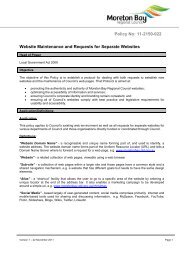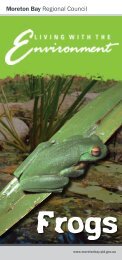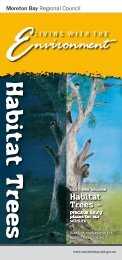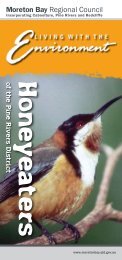South East Queensland Ecological Restoration Framework: Manual
South East Queensland Ecological Restoration Framework: Manual
South East Queensland Ecological Restoration Framework: Manual
Create successful ePaper yourself
Turn your PDF publications into a flip-book with our unique Google optimized e-Paper software.
5.3.3.3 Scrape-paint<br />
Scrape as much of the stem as possible (one side of the stem)<br />
using a knife and apply herbicide to the scrape. Leave a small<br />
section of the vine unscraped, and then twist the vine so that<br />
the next scrape is made on the opposite side of the stem to<br />
the preceding scrape. Continue along the length of the vine,<br />
scraping and painting as much of the stem as possible, with<br />
scraping to be concentrated along the thicker stems close<br />
to the root of the plant. This is the best method to use for<br />
madeira vine, as it allows the chemical to translocate to the<br />
Figure 6 – Scrape-Paint<br />
underground storage organs and aerial tubers which may be<br />
hanging in large clusters above head height. This avoids the potential problem of tubers from cut stems<br />
left hanging in the trees from dropping to the ground and sprouting. When scraping madeira vine stems<br />
a deep scrape is advisable – scrape right through to the fibrous, stringy section of the stem, taking care<br />
not to sever the vine. This method is also suitable for treatment of ochna. Case Study 3 describes how this<br />
method was used successfully to control cat’s claw creeper (Macfadyena unguis-cati).<br />
5.3.3.4 Over-spraying<br />
Over-spraying involves the use of knapsacks or power sprayers<br />
to treat large expanses of weed such as lantana thickets. The<br />
foliage must be covered with herbicide but not to the point<br />
of running off the plant. The dead plants remain in place<br />
and can be cut down at a later stage or left in situ to provide<br />
protection for emerging seedlings. Prior to over-spraying, any<br />
weeds that are growing closely around established native<br />
plants must be hand removed or treated by cut-scrape-paint.<br />
It may be necessary to cut access tracks so that all sections of<br />
Figure 7 – Over-spraying<br />
the expanse of weed are easily reached by the operator. Tracks<br />
that are cut must take into account the distance that the chemical can be projected, which will depend<br />
on the equipment that is being used. Generally, power sprayers can project the chemical further than is<br />
possible with a knapsack, though power spraying is often not suitable on sites where native plants are<br />
present due to the likelihood of off-target damage. Native and exotic vines may take advantage of the<br />
dead frames and timely follow-up is necessary.<br />
Over-spraying is advantageous as it leaves the dead plants intact to prevent erosion and over-exposure<br />
of large areas, protects native seedlings from herbivores such as wallabies, retains the structure and<br />
avoids trampling by humans. Leave the sprayed plants intact for as long as possible so that native<br />
seedlings can establish under the shelter provided.<br />
Boom spraying is of limited application for most ecological restoration work, however, it may<br />
occasionally be useful when preparing large areas for planting (either Reconstruction or Fabrication).<br />
5.3.3.5 Splatter gun<br />
This small gas-powered injector kit is fitted into a knapsack for easy carrying and delivers large<br />
droplets in a stream over the weed. The gun is used to deliver a concentrated herbicide (glyphosate<br />
or metsulfuron methyl) across large dense expanses of weed. The method is used for species such as<br />
lantana (ratio of 1:9 of glyphosate:water). Splatter gun involves spraying strips at one to two metre<br />
intervals over the thicket. The herbicide is then translocated throughout the entire plant. Because it is<br />
gas-powered, the splatter gun can project the herbicide long distances, reducing the number of access<br />
tracks that need to be cut prior to spraying in large or difficult to access sites. The method does not<br />
require the whole plant to be covered as in over-spray.<br />
SEQ <strong>Restoration</strong> <strong>Framework</strong><br />
96<br />
MANUAL


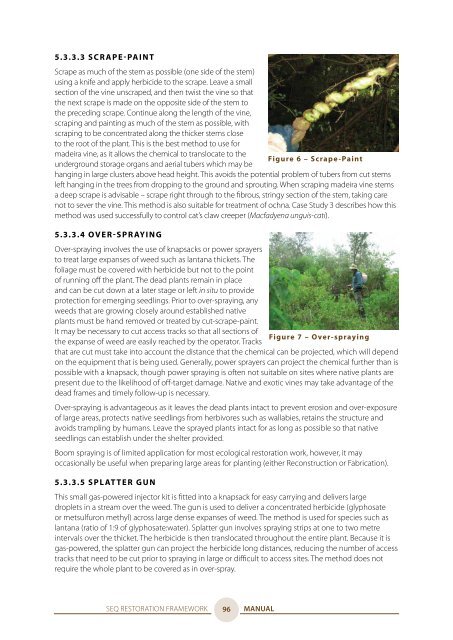
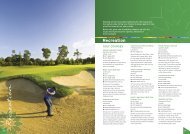

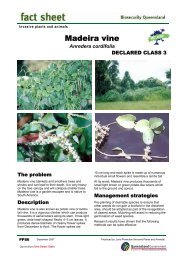
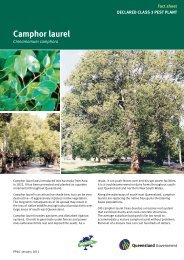


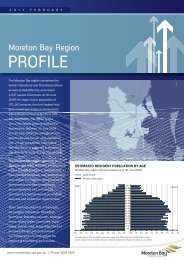
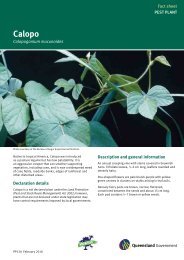

![Kumbartcho Brochure [PDF 540KB] - Moreton Bay Regional Council](https://img.yumpu.com/47220970/1/190x101/kumbartcho-brochure-pdf-540kb-moreton-bay-regional-council.jpg?quality=85)
